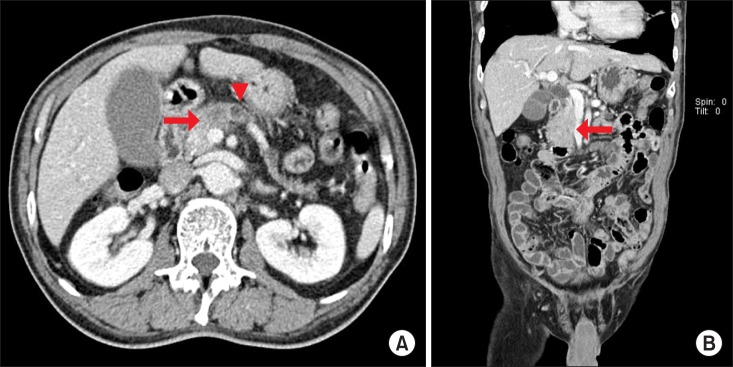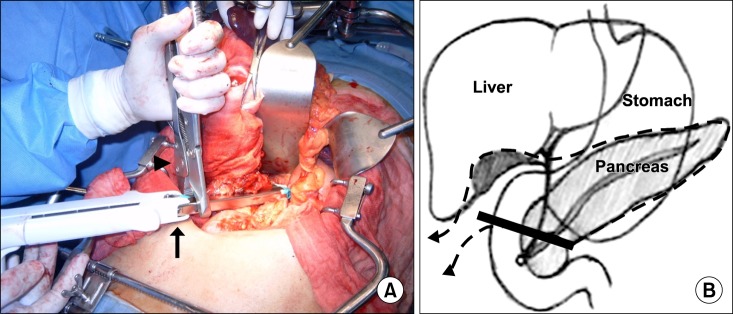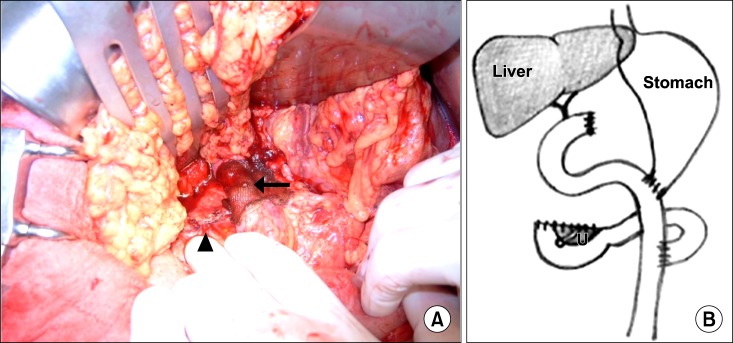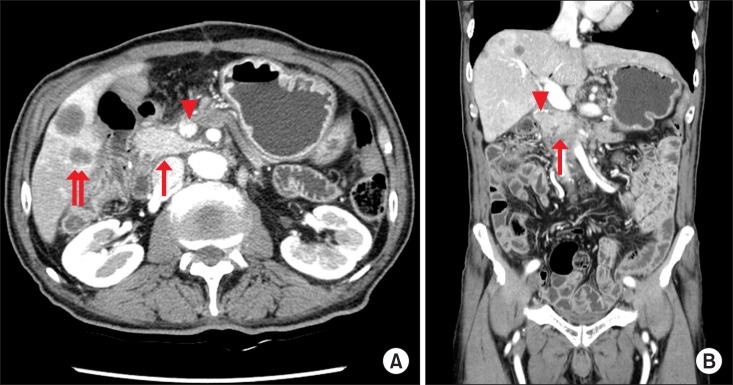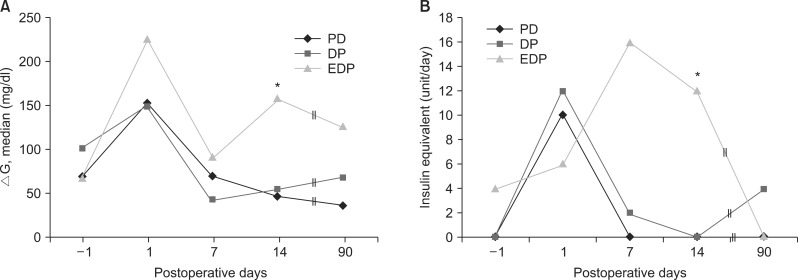Korean J Hepatobiliary Pancreat Surg.
2014 Aug;18(3):77-83. 10.14701/kjhbps.2014.18.3.77.
Extended distal pancreatectomy for advanced pancreatic neck cancer
- Affiliations
-
- 1Department of Surgery, Inha University School of Medicine, Incheon, Korea. 196087@inha.ac.kr
- KMID: 1802218
- DOI: http://doi.org/10.14701/kjhbps.2014.18.3.77
Abstract
- BACKGROUNDS/AIMS
We investigated the clinical application of extended distal pancreatectomy in patients with pancreatic neck cancer accompanied by distal pancreatic atrophy. In this study, we have emphasized on the technical aspects of using the linear stapling device for a bulky target organ.
METHODS
From March 2010 to September 2013, 46 patients with pancreatic adenocarcinoma, who underwent pancreatic resection with radical intent at our institute, were reviewed retrospectively. Among them, three patients (6.5%) underwent extended distal pancreatectomy. A linear stapling device and vise-grip locking pliers were used for en bloc resection of the distal pancreas, first duodenal portion, and distal common bile duct. The results were compared with those after standard pancreatectomy.
RESULTS
All three patients presented with jaundice, and the ratio of pancreatic duct to parenchymal thickness of the pancreatic body was greater than 0.5. Grade A pancreatic fistula developed in all of the cases, but none of these fistulae were lethal. Pathological staging was T3N1M0 in all of the patients. The postoperative daily serum glucose fluctuations and insulin requirements were comparable to those in patients who received pancreaticoduodenectomy or distal pancreatectomy. At the last follow-up, two patients were alive with liver metastasis at 4 and 10 months postoperatively, respectively, and one patient died of liver metastasis at 5 months postoperatively.
CONCLUSIONS
While the prognosis of advanced pancreatic neck adenocarcinoma is still dismal, extended distal pancreatectomy is a valid treatment option, especially when there is atrophy of the distal pancreas. Also, the procedure is technically feasible, and further refinement is necessary to improve patient survival.
Keyword
MeSH Terms
Figure
Reference
-
1. Orr RK. Outcomes in pancreatic cancer surgery. Surg Clin North Am. 2010; 90:219–234. PMID: 20362783.
Article2. Tempero MA, Arnoletti JP, Behrman SW, Ben-Josef E, Benson AB 3rd, Casper ES, et al. Pancreatic Adenocarcinoma, version 2.2012: featured updates to the NCCN Guidelines. J Natl Compr Canc Netw. 2012; 10:703–713. PMID: 22679115.3. Karasawa E, Goldberg HI, Moss AA, Federle MP, London SS. CT pancreatogram in carcinoma of the pancreas and chronic pancreatitis. Radiology. 1983; 148:489–493. PMID: 6867347.
Article4. Bassi C, Dervenis C, Butturini G, Fingerhut A, Yeo C, Izbicki J, et al. Postoperative pancreatic fistula: an international study group (ISGPF) definition. Surgery. 2005; 138:8–13. PMID: 16003309.
Article5. Slezak LA, Andersen DK. Pancreatic resection: effects on glucose metabolism. World J Surg. 2001; 25:452–460. PMID: 11344398.
Article6. Kahl S, Malfertheiner P. Exocrine and endocrine pancreatic insufficiency after pancreatic surgery. Best Pract Res Clin Gastroenterol. 2004; 18:947–955. PMID: 15494288.
Article7. Shimada K, Sakamoto Y, Esaki M, Kosuge T, Hiraoka N. Role of medial pancreatectomy in the management of intraductal papillary mucinous neoplasms and islet cell tumors of the pancreatic neck and body. Dig Surg. 2008; 25:46–51. PMID: 18292661.
Article8. Christein JD, Kim AW, Golshan MA, Maxhimer J, Deziel DJ, Prinz RA. Central pancreatectomy for the resection of benign or low malignant potential neoplasms. World J Surg. 2003; 27:595–598. PMID: 12715230.
Article9. Sato N, Yamaguchi K, Yokohata K, Shimizu S, Morisaki T, Chijiiwa K, et al. Short-term and long-term pancreatic exocrine and endocrine functions after pancreatectomy. Dig Dis Sci. 1998; 43:2616–2621. PMID: 9881491.10. Choi MG, Kim SW, Jang JY, Yoon YS, Park YH. Long-term functional outcome after pancreatoduodenectomy. Korean J Hepatobiliary Pancreat Surg. 2004; 8:20–30.11. Poon RT, Lo SH, Fong D, Fan ST, Wong J. Prevention of pancreatic anastomotic leakage after pancreaticoduodenectomy. Am J Surg. 2002; 183:42–52. PMID: 11869701.
Article12. Lermite E, Sommacale D, Piardi T, Arnaud JP, Sauvanet A, Dejong CH, et al. Complications after pancreatic resection: diagnosis, prevention and management. Clin Res Hepatol Gastroenterol. 2013; 37:230–239. PMID: 23415988.
Article13. Fang WL, Su CH, Shyr YM, Chen TH, Lee RC, Tai LC, et al. Functional and morphological changes in pancreatic remnant after pancreaticoduodenectomy. Pancreas. 2007; 35:361–365. PMID: 18090244.
Article14. Huang JJ, Yeo CJ, Sohn TA, Lillemoe KD, Sauter PK, Coleman J, et al. Quality of life and outcomes after pancreaticoduodenectomy. Ann Surg. 2000; 231:890–898. PMID: 10816633.
Article
- Full Text Links
- Actions
-
Cited
- CITED
-
- Close
- Share
- Similar articles
-
- Surgical Management of Pancreatic Cancer
- Current status of robotic surgery for pancreatic tumors
- Predictors of postoperative pancreatic fistula after splenectomy with or without distal pancreatectomy performed as a component of cytoreductive surgery for advanced ovarian cancer
- A Case of a Traumatic Pancreatic Neck Transection Treated with a Binding Pancreaticogastrostomy
- Pancreatic Diabetes after Distal Pancreatectomy: Incidence Rate and Risk Factors

